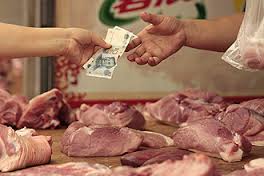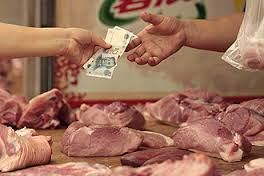
Even as farmers and meat packers in both nations battle for lucrative shares of the biggest global market, Canada has overtaken the United States as the top North American supplier of pork to China.
After a sharp rise last year, in the first quarter of 2017, Canada's pork sales to China exceeded those of the United States. According to U.S. and Canadian government data that's only happened a handful of times in two decades.
Parts of the pig - feet, elbows, innards - which command little value in most countries, sees voracious appetite for pork in China driven by rising affluence. Demand for cheaper imports is boosted and farm closures have bene forced by tightened environmental standards in China.
Largely because it is banned in China, which consumes half the world's pork, Canadian farmers, who have almost completely removed the growth drug ractopamine from their pigs' diet and the tightened regulations is a bonanza for Canadian farmers.
According to U.S. hog producers, meat packers and animal feed dealers, since only about half of the nation's herd has been weaned off the drug, U.S. exports to China, by contrast, are limited.
Now three of the biggest pork producers in the U.S. - Smithfield Foods [SFII.UL]; Seaboard Foods, a division of Seaboard Corp; and Triumph Foods, a hog farmer cooperative, are moving to produce more ractopamine-free hogs.
The power of the gargantuan Chinese market to influence agricultural practices and profits in supplier countries worldwide is underscored by the ascension of Canada's pork exports.
Some 333,000 tonnes, more than double of Canada's shipments of 161,000 tonnes, was achieved by annual U.S. pork sales to China as recently as 2013.
Ractopamine, best known as Eli Lilly & Co product Paylean, was being started to be removed by Canada's hog industry at about the same year.
On pace to hit 372,000 tonnes annually, Canada shipped nearly 93,000 tonnes of pork to China in the first quarter of this year. According to data from both governments, that eclipsed the 87,500 tonnes that the United States shipped.
Sending 393,365 tonnes there in the first quarter, China's top foreign pork supplier was the European Union, which has long banned ractopamine.
In 2002, the use of ractopamine in livestock was banned by Chinese authorities. The authorities said that the meat that used the drug could be life-threatening to sufferers of heart disease and can cause nausea and diarrhea in people.
And concluding that it would "not have a significant impact on the human environment", the U.S. Food and Drug Administration, however, did not see the same dangers when it approved ractopamine in 1999.
Canada's HyLife started selling pork online directly to Chinese consumers last year because the China market is so lucrative.
The small Manitoba processor elbows on e-commerce site JD.com Inc, a competitor of Alibaba Group Holding Ltd. and hawks pig feet.
"They're big online buyers," said Claude Vielfaure, HyLife's chief operating officer. "You try to move your pork all kinds of ways."
Prices for by-products including pigs' feet, kidneys and livers have been driven up due to rising Chinese pork demand.
Followed by Taiwan and Philippines, China is the biggest byproduct market.
(Source:www.reuters.com)
After a sharp rise last year, in the first quarter of 2017, Canada's pork sales to China exceeded those of the United States. According to U.S. and Canadian government data that's only happened a handful of times in two decades.
Parts of the pig - feet, elbows, innards - which command little value in most countries, sees voracious appetite for pork in China driven by rising affluence. Demand for cheaper imports is boosted and farm closures have bene forced by tightened environmental standards in China.
Largely because it is banned in China, which consumes half the world's pork, Canadian farmers, who have almost completely removed the growth drug ractopamine from their pigs' diet and the tightened regulations is a bonanza for Canadian farmers.
According to U.S. hog producers, meat packers and animal feed dealers, since only about half of the nation's herd has been weaned off the drug, U.S. exports to China, by contrast, are limited.
Now three of the biggest pork producers in the U.S. - Smithfield Foods [SFII.UL]; Seaboard Foods, a division of Seaboard Corp; and Triumph Foods, a hog farmer cooperative, are moving to produce more ractopamine-free hogs.
The power of the gargantuan Chinese market to influence agricultural practices and profits in supplier countries worldwide is underscored by the ascension of Canada's pork exports.
Some 333,000 tonnes, more than double of Canada's shipments of 161,000 tonnes, was achieved by annual U.S. pork sales to China as recently as 2013.
Ractopamine, best known as Eli Lilly & Co product Paylean, was being started to be removed by Canada's hog industry at about the same year.
On pace to hit 372,000 tonnes annually, Canada shipped nearly 93,000 tonnes of pork to China in the first quarter of this year. According to data from both governments, that eclipsed the 87,500 tonnes that the United States shipped.
Sending 393,365 tonnes there in the first quarter, China's top foreign pork supplier was the European Union, which has long banned ractopamine.
In 2002, the use of ractopamine in livestock was banned by Chinese authorities. The authorities said that the meat that used the drug could be life-threatening to sufferers of heart disease and can cause nausea and diarrhea in people.
And concluding that it would "not have a significant impact on the human environment", the U.S. Food and Drug Administration, however, did not see the same dangers when it approved ractopamine in 1999.
Canada's HyLife started selling pork online directly to Chinese consumers last year because the China market is so lucrative.
The small Manitoba processor elbows on e-commerce site JD.com Inc, a competitor of Alibaba Group Holding Ltd. and hawks pig feet.
"They're big online buyers," said Claude Vielfaure, HyLife's chief operating officer. "You try to move your pork all kinds of ways."
Prices for by-products including pigs' feet, kidneys and livers have been driven up due to rising Chinese pork demand.
Followed by Taiwan and Philippines, China is the biggest byproduct market.
(Source:www.reuters.com)














